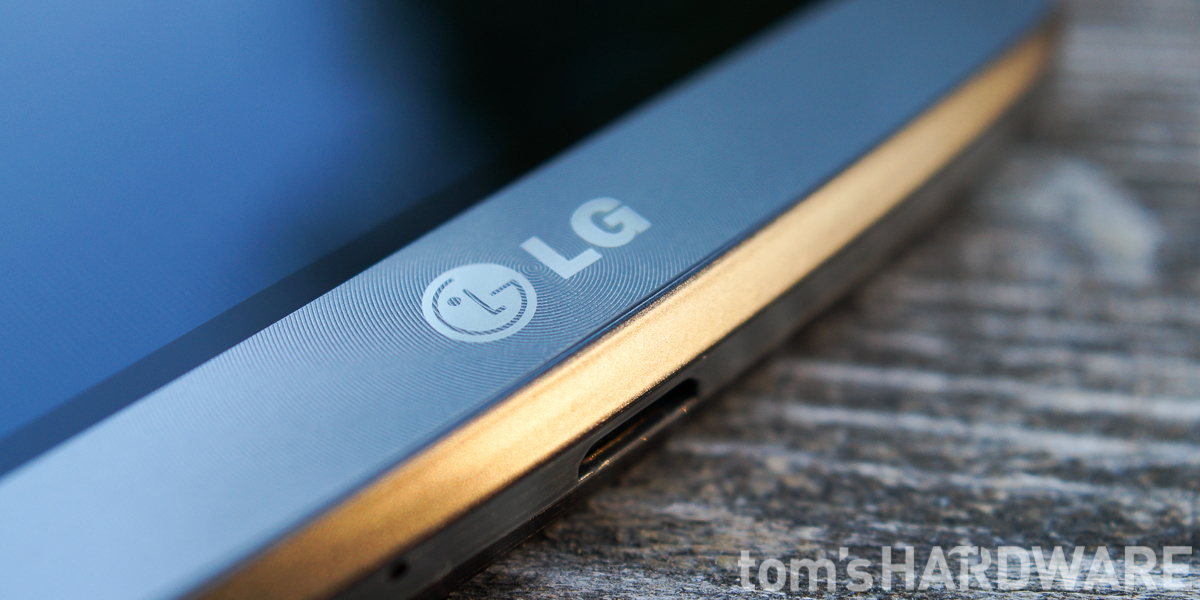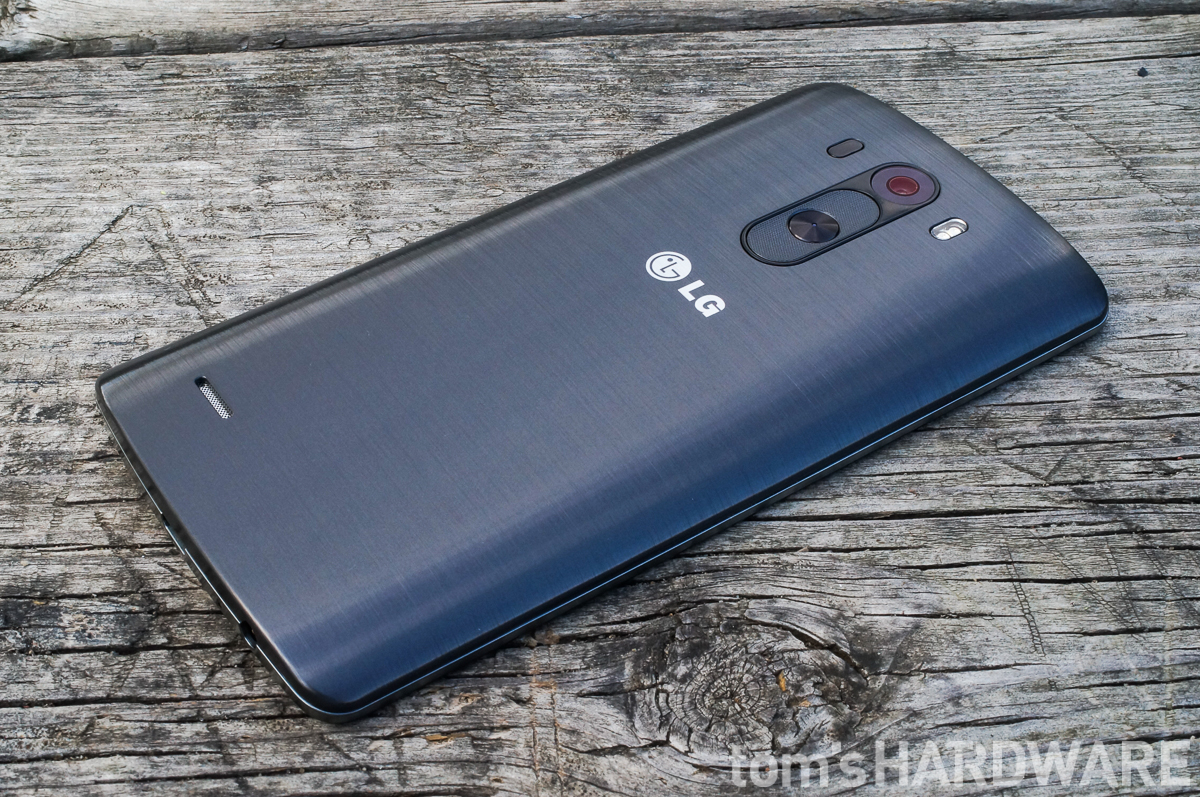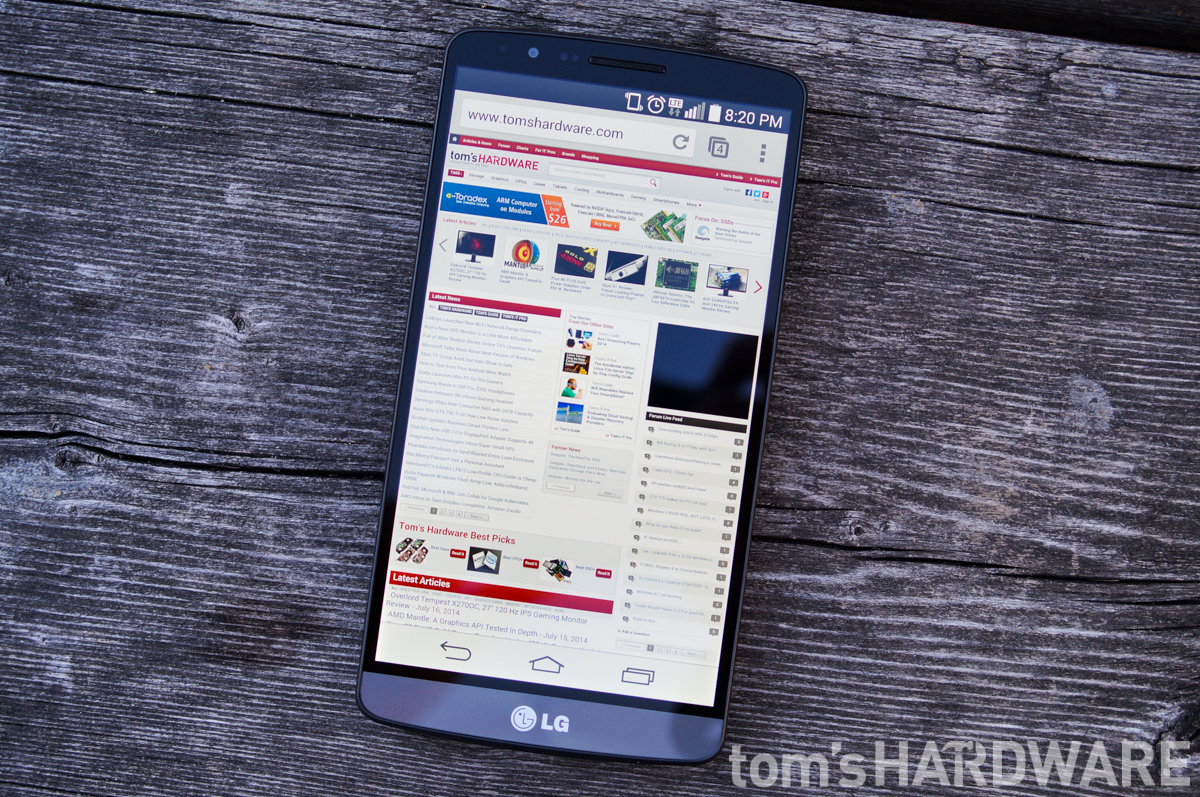LG G3 Smartphone Review: A Plethora Of Pixels And A Laser!
The LG G3 combines cutting-edge hardware, including a 5.5-inch WQHD screen and laser autofocus system, with a lightweight body and slim bezels to create a phone that was ahead of its time. Is it still worth your consideration? Read on for our impressions.
Why you can trust Tom's Hardware
Better To Be Fashionably Late Then Impatiently Early
The G3 is a stylish phone, with a convincing brushed metal finish on the back and no garish border around the glass on the front. We especially like the design of the rear camera and button stack. The textures and contours of the buttons contrast nicely with the smooth brushed metal look, and the symmetry between the laser and flash also enhances its appeal. While it doesn’t have the customization options like the Moto X, the G3 does come in a variety of colors (at least in most markets).
Foregoing physical navigation buttons helps LG minimize the bezel and the G3’s overall size. Despite its larger screen, it isn’t much bigger than HTC's One (M8) or Samsung's Galaxy S5. The reduction in size and all-plastic construction collectively trim weight. Surprisingly, the G3 is only 3% heavier than the 5.1-inch plastic S5.
Combining a curved back with the smaller, lightweight frame creates a great in-hand feel. It doesn’t dig into your palm while holding it, and it remains comfortable to grasp in both portrait and landscape modes. The smooth back does make it feel a bit slippery though, and while it may be the smallest phone with a 5.5-inch screen, this phone is best experienced with two hands.
LG’s most radical design decision, though, was to relocate the remaining physical buttons to the back of the phone. This does take a little getting used to, but I’ve grown to like the arrangement. After picking up the phone, I’ve learned to quickly locate the buttons, and their position puts them within easy reach. This also eliminates the issue of inadvertently pressing buttons on the sides, a problem that I encounter frequently with other phones.
LG’s eye for design carries over into the software, too. Blending a simplified, flatter aesthetic with consistent use of muted colors creates an attractive UI that in many ways resembles Google’s own Material design language.
The Dual Window and QSlide features help take full advantage of the G3’s larger screen. While four different windows open at the same time might not be practical, even for a 5.5-inch display, having two windows open, either by using Dual Window or a QSlide app sitting above a full-screen app, is immensely helpful and saves me from the hassle of constantly bouncing back and forth between apps.
Other notable features include Guest Mode, a terrific feature for parents who want to let their children use the phone. Using Knock On to turn the screen on or off by tapping it twice works well and is convenient; it’s definitely a feature we miss when moving to a different phone. Similarly, Knock Code is a welcome addition to securing the device.
Get Tom's Hardware's best news and in-depth reviews, straight to your inbox.
Not all of LG’s software features are praiseworthy. We didn’t find Smart Notice to be particularly helpful. The note-taking app QuickMemo+ is decent, but it doesn’t really stand out as anything special. The one area where LG really falls short is the notification shade. With half of the screen taken up by controls, there isn’t enough room left for notifications. We would prefer having the controls and notifications on separate tabs, or splitting it into two shades accessible by pulling down from either the left or right side of the screen.
Despite reliance on a previous-generation Sony sensor, the G3’s camera performs well. When lighting is good, whether in daylight outdoors or with bright lighting indoors, the G3 produces images with accurate white balance and vivid color. It also uses sufficiently fast shutter speed to avoid problems with overexposure. In lower-light conditions, the G3 leverages its OIS+ to keep the shutter open longer, capturing more light, while holding ISO low and reducing noise. Even though the G3 performs better than many competing cameras in low light, it doesn’t match the performance of the iPhone and its larger pixels.
The G3’s unique laser autofocus system is extremely fast and works well, even performing better than the iPhone 6 Plus’ phase detection autofocus in low contrast scenes. However, the total image capture time is a tad slow, making it feel more like a previous-generation device.
Internal hardware is appropriate for a flagship phone, including a Snapdragon 801 SoC, a generous 3GB of RAM and 32GB of internal storage. All of the current wireless protocols are covered (802.11ac Wi-Fi, Bluetooth 4, NFC, Cat. 4 LTE) and LG adds microSD card support and a removable battery, both missing from 2013's G2. Dust and water resistance didn’t get an invite to the G3 party, unfortunately.
The G3’s headlining hardware feature, the WQHD screen, is ironically its biggest detriment. Part of the problem is software (color compression and overly aggressive sharpening filter), part of it is the panel (maximum brightness below 400 nits and excessive IPS glow) and the final part is simply timing. Rather than waiting for the Snapdragon 805 to become available, like Samsung and Google did for the WQHD-equipped Note 4 and Nexus 6, LG opted to be the first with 1440p in North America. That was a marketing win that meant Qualcomm's Snapdragon 801 would be asked to drive its high-res screen. Unfortunately, the Adreno 330 GPU can’t handle this many pixels, resulting in poor gaming performance and increased battery drain as the GPU struggles to keep up. In this respect, the G3 is ahead of its time.
Overall, the LG G3 is still a great phone with more pluses than minuses. If LG used a high-quality 1080p display instead of rushing to 1440p, the G3 might qualify as the best flagship phone for this generation. If you’re not a big phone gamer, can overlook the minor display aberrations and can settle for good but not great battery life, than you’ll be really happy with the G3.
>> See the Reader Ratings and Advice for the LG G3
Follow Alex Davies and Tom’s Hardware on Facebook/Google+/Twitter.
Current page: Better To Be Fashionably Late Then Impatiently Early
Prev Page Results: Battery And Throttling-
Vorador2 At this point, i wouldn't bother. Rumors have surfaced than a successor will be launched in March.Reply
Tom's, you're almost at the point of self-parody. I would rename the site to "The Slowest Authority on Tech" -
wtfxxxgp For once I must agree that THW has dropped the ball on a very important phone review - it was too late - and the "better late than never" gesture never applies to a Review of something. My sister has just purchased this phone a week ago, had I had sight of a THW review then I'm sure I could have convinced her to rather wait for the next model that would surely have better support for that gorgeous screen - I played with it, it really is amazing watching video on that thing.Reply -
zodiacfml It's quite late and learned little except the voice activated shutter feature. Most of the information are subjective and benchmarks are quite of little use since the database is quite few.Reply
Tom's, here is a suggestion. Since you're good with gaming benchmarks, why not just make reviews of smartphones as portable gaming machines? There's plenty of information to be gathered from such and plenty of debates/discussion could be created just from that.
Build a database of old games and phones to be compared to new devices. Higher benchmark numbers encourages upgrades (*wink*). -
Cryio Absolutely no Lumia in the photo shoot comparison? I thought. A Lumia 1020 or Lumia 930 with Denim should have photo sampling comparisons in the next list. Also an iPhone 6+.Reply -
bujcri Suprised not to be mentioned about LG's Lollipop update for LG G3. At least worth mentioning that this update pretty much ruined some funtions on G3 like silent mode (now DND) and brought a lot of useless notifications on lockscreen like for example whatever you wanna have permanently on the notification bar (I used to have the date there). In a nutshell I really hate Lollipop.Reply -
kiniku I sold this phone on Ebay and bought a Sony Xperia Z3. I went from 8-10 hours of battery life to 48+, brighter screen, water resistant, and amazing sound.Reply -
glasssplinter I had to look at this article several times to confirm that you really just published this. New phone models are just around the corner and you're barely pushing this article out. Why did you feel the need to compare so many features to crapple tech also? The whole reason I'm interested in the phone is because it isn't crapple so people don't care how it stacks up. We want to know how it compares to other android phones. It's like putting the newest icrap review out and then saying but the icrap 10 still doesn't have a removable battery but this android and windows phone does in some hope of swaying them. Tom's has hit new lows...you would have been better off just not publishing this.Reply -
MobileEditor ReplyMan! I can't wait for the new Samsung Galaxy S4 review!
Don't buy it. Review done :)
- Matt H.


